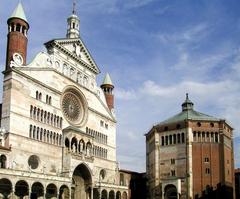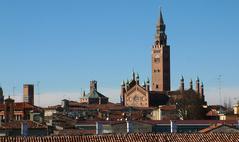Visiting Hours and Tickets for Cattedrale di Santa Maria Assunta, Cremona: A Complete Guide
Publication Date: 31/07/2024
Introduction to Cattedrale di Santa Maria Assunta
The Cattedrale di Santa Maria Assunta, commonly known as Cremona Cathedral, stands as an architectural gem in the heart of Cremona, Italy. This iconic structure, renowned for its blend of Romanesque and Gothic styles, has been a focal point of religious, cultural, and historical significance since its inception in the 12th century. The cathedral not only serves as a place of worship but also as a testament to the rich artistic and architectural heritage of the region. Visitors are often captivated by its intricate façade, towering bell tower (the Torrazzo), and the stunning frescoes and artworks that adorn its interior (Cremona Cathedral History). This guide aims to provide a comprehensive overview of the cathedral’s history, architectural evolution, and cultural impact, along with practical information for those planning a visit.
Contents Overview
- Introduction
- Historical Overview of Cattedrale di Santa Maria Assunta, Cremona
- Early Beginnings and Construction
- Architectural Evolution
- Artistic Contributions
- Historical Significance
- Preservation and Restoration
- Cultural Impact
- Visitor Information
- Cremona Cathedral Visiting Hours
- Cattedrale di Santa Maria Assunta Tickets
- Travel Tips
- Nearby Attractions
- Accessibility
- FAQ
- Conclusion
Historical Overview of Cattedrale di Santa Maria Assunta, Cremona
Early Beginnings and Construction
The construction of the cathedral began in 1107, but it faced significant delays due to a devastating earthquake in 1117. This natural disaster necessitated extensive rebuilding efforts, which were completed in 1190. The cathedral’s initial design was Romanesque, characterized by its robust and solid architectural elements.
Architectural Evolution
Over the centuries, the cathedral underwent numerous modifications, reflecting various architectural styles. The most significant transformation occurred during the 13th and 14th centuries when Gothic elements were introduced. The addition of the façade, completed in 1490, is a prime example of this Gothic influence. The façade features intricate sculptures and detailed stonework, showcasing the craftsmanship of the era.
The Torrazzo, the cathedral’s bell tower, is another architectural marvel. Standing at 112 meters, it is one of the tallest brick towers in Europe. Construction of the Torrazzo began in 1230 and was completed in 1309. The tower houses the largest astronomical clock in the world, installed in 1583, which remains a significant attraction for visitors (Cremona Cathedral History).
Artistic Contributions
The interior of the cathedral is a treasure trove of artistic masterpieces. The frescoes adorning the walls and ceilings were created by renowned artists such as Boccaccio Boccaccino, Altobello Melone, and Bernardino Gatti. These frescoes, painted between the 16th and 17th centuries, depict various biblical scenes and are celebrated for their vivid colors and intricate details.
One of the most notable artworks is the ‘Assumption of the Virgin’ by Boccaccio Boccaccino, located in the apse. This fresco, completed in 1518, is a stunning representation of the Virgin Mary’s ascension to heaven, surrounded by angels and saints. The cathedral also houses several altarpieces and sculptures, including works by Giulio Campi and Antonio Campi, which further enhance its artistic significance (Cremona Cathedral Art).
Historical Significance
The Cattedrale di Santa Maria Assunta has played a pivotal role in the religious and cultural life of Cremona. It has been the site of numerous significant events, including the coronation of bishops and the celebration of important religious festivals. The cathedral’s historical importance is also reflected in its status as a UNESCO World Heritage site, recognized for its architectural and artistic value.
During the Renaissance, Cremona was a thriving center of art and music, and the cathedral served as a focal point for these cultural activities. The city’s rich musical heritage, particularly its association with the famous luthier Antonio Stradivari, is intertwined with the history of the cathedral. Stradivari himself was a frequent visitor to the cathedral, and his violins are considered some of the finest ever made (UNESCO World Heritage).
Preservation and Restoration
Preserving the historical and architectural integrity of the Cattedrale di Santa Maria Assunta has been a priority for centuries. Various restoration projects have been undertaken to maintain the cathedral’s structural stability and aesthetic beauty. One of the most significant restoration efforts occurred in the 19th century when the cathedral’s façade and interior were meticulously restored to their original splendor.
In recent years, modern technology has been employed to ensure the cathedral’s preservation. Advanced techniques such as laser cleaning and 3D scanning have been used to restore and document the intricate details of the cathedral’s artwork and architecture. These efforts have been crucial in safeguarding the cathedral for future generations to appreciate and enjoy (Restoration Techniques).
Cultural Impact
The Cattedrale di Santa Maria Assunta is not only a religious landmark but also a cultural icon in Cremona. It serves as a venue for various cultural events, including concerts, art exhibitions, and historical reenactments. The cathedral’s rich history and stunning architecture make it a popular destination for tourists and scholars alike.
The annual Festa del Torrone, a festival celebrating Cremona’s famous nougat, often includes events held at the cathedral. This festival attracts thousands of visitors each year, highlighting the cathedral’s role as a central hub of cultural activity in the city. The cathedral’s influence extends beyond its religious significance, making it an integral part of Cremona’s cultural identity (Festa del Torrone).
Visitor Information
Cremona Cathedral Visiting Hours
The cathedral is open to visitors from Monday to Saturday, 9:00 AM to 12:30 PM and 3:00 PM to 6:30 PM. On Sundays and holidays, the hours are 9:00 AM to 1:00 PM and 3:00 PM to 6:30 PM. It is advisable to check the official website for any changes in visiting hours due to special events or maintenance work.
Cattedrale di Santa Maria Assunta Tickets
Entry to the cathedral is free, but donations are welcome to support ongoing preservation efforts. Guided tours are available for a fee and can be booked in advance through the cathedral’s official website.
Travel Tips
- Dress Code: Visitors are expected to dress modestly. Shoulders and knees should be covered to respect the sacred nature of the site.
- Photography: While photography is allowed, the use of flash is prohibited to preserve the delicate artworks.
- Best Time to Visit: The cathedral is less crowded during weekday mornings, making it an ideal time for a quiet and reflective visit.
Nearby Attractions
While visiting the cathedral, consider exploring other nearby historical sites and attractions in Cremona:
- Torrazzo of Cremona: Adjacent to the cathedral, this towering structure offers breathtaking views of the city.
- Museo del Violino: A museum dedicated to the history and craftsmanship of violins, showcasing instruments by Stradivari and other famous luthiers.
- Piazza del Comune: The main square of Cremona, surrounded by beautiful medieval buildings and a lively atmosphere.
Accessibility
The cathedral is accessible to visitors with disabilities. Ramps and elevators are available to ensure that everyone can enjoy the beauty and history of this remarkable site.
Frequently Asked Questions
Q: What are the opening hours of Cremona Cathedral? A: The cathedral is open from Monday to Saturday, 9:00 AM to 12:30 PM and 3:00 PM to 6:30 PM. On Sundays and holidays, the hours are 9:00 AM to 1:00 PM and 3:00 PM to 6:30 PM.
Q: How much do tickets cost for Cattedrale di Santa Maria Assunta? A: Entry to the cathedral is free, but donations are appreciated to support preservation efforts. Guided tours are available for a fee.
Q: Are guided tours available? A: Yes, guided tours are available and can be booked in advance through the cathedral’s official website.
Conclusion
The Cattedrale di Santa Maria Assunta in Cremona is a remarkable example of historical and architectural evolution. From its Romanesque beginnings to its Gothic transformations and Renaissance artistic contributions, the cathedral embodies the rich cultural heritage of Cremona. Its historical significance, coupled with ongoing preservation efforts, ensures that it remains a cherished landmark for generations to come.
For more information, download the Audiala mobile app, check out related posts on our site, and follow us on social media for updates.

